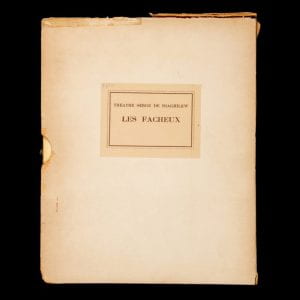Going to the ballet—A new addition to the Rare Music Collection
The Baillieu Library’s Rare Music Collection has recently welcomed an exciting new addition. This work comprises two volumes, as part of a limited edition of five hundred, and was dedicated to a Ballets Russes performance of Les Fâcheux at Paris’ Théâtre de Monte Carlo in 1924. This performance was based on a three-part comedy of Molière’s, with music by Georges Auric, choreography by Bronislava Nijinska, along with costume and set design by Georges Braque.

The Ballets Russes was an itinerant ballet company, developed by Sergei Diaghilev, which toured across Europe and North America between 1909 and 1929. They were enormously influential on 20th-century dance and theatre, with their daring and sensual performances bringing ballet into a new era. While the company was based in Paris and never performed in Russia, the striking costumes, music, and choreography were conspicuously Russian in their design. The first seasons of Ballets Ruses featured costume design by Russian-born Léon Bakst, whose designs of exuberant colours and avant-garde shapes, along with the forward-thinking choreography of virtuosic dancer Vaslav Nijinsky, established the innovation and audaciousness of the company.
The first volume of this acquisition comprises of two critical works from French critics Jean Cocteau and Louis Laloy, a portrait of the ballet’s composer Auric by Cocteau, a reproduction of a page of the score, and 23 hand coloured lithographs of Braque’s costumes and sets. A lithograph is an image-making technique which requires drawing with a waxy crayon on a stone, often marble, slab; ink is then rolled on the slab and when pressed the raised wax lines are reproduced on paper. While lithographs allow a degree of consistency between prints, the hand-coloured details of these images add a charming individuality with their delicately painted lace ruffles and feathered hats.
The second volume contains 23 black and white photographs of the dancers in costume and stylishly posed with their props. Together, the two volumes of this work provide an in-depth resource for the 1924 Ballets Russes production of Les Fâcheux, speaking to its critical reception, music composition, costume, and performers. This piece will be an excellent resource for the OBL sessions run by Professor Kerry Murphy during the Paris! From Berlioz to the Ballets Russes subject, as well as for those studying the third-year Music History core subject Twentieth Century Music and Ideas. For those interested in early-20th century European ballet, performance, and theatre, this acquisition will undoubtedly be a valuable resource and very welcome addition to the Rare Music Collection.
![Dancer Ninette de Valois in Les facheux, 1924 [photographer unknown].](https://blogs.unimelb.edu.au/librarycollections/files/2020/10/dancer-with-racquets-002-224x300.jpg)
Print Room Intern.
Leave a Reply